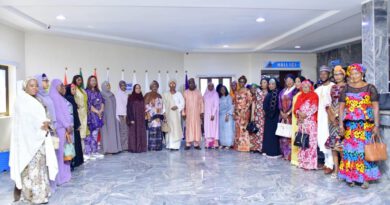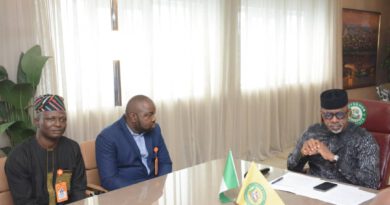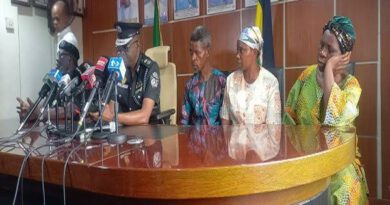LET US REDEVELOP RANDLE HEALTH CENTRE TO A 21ST CENTURY SECONDARY TIER MEDICAL FACILITY
By Ogboni Fouad Oki
I begin this rejoinder with a clear disclaimer: I am not holding brief for Rt. Hon. Femi Gbajabiamila, nor am I under any obligation to defend him. The man in question is more than capable of explaining his own involvement or interventions on the proposed project, should he so desire. My sole objective here is to set the record straight, to correct misconceptions that have crept into the public discourse, and to articulate why the redevelopment of Randle Health Centre, popularly referred to now as Randle General Hospital, into a modern medical facility is not only desirable but imperative for the health and well-being of the people of Surulere and Lagos State at large.
Correcting the Historical Fallacy
Major-General Olanrewaju’s letter “Do not demolish Randle Hospital” suggests that Randle Hospital was built in 1961 by the then Lagos Primary Health Commission in honour of Chief J.K. Randle. With due respect, this is historically inaccurate. While Chief J.K. Randle is indeed one of Lagos’ illustrious sons, an athlete, philanthropist, and cultural icon, there is no verifiable record that he either built or directly contributed to the establishment of the health facility in question. Indeed, there was no Lagos Primary Health Commission, rather it was Lagos Town Council’s Medical Officer of Health Department, which was the supervisory & Coordinating department of the Town Council then.
What is known, and what is corroborated by multiple historical and institutional sources, is that Randle Health Centre (New Lagos) was established in 1964. Its origins are often attributed to Chief M.A. Majekodunmi, a notable Nigerian statesman, physician, and public servant. Some sources, including the Lagos Ministry of Health itself, identify him as the initiator or benefactor who supported the establishment of the hospital.
The Lagos Town Council, created in 1917 and later transformed into the Lagos City Council in 1963, had already assumed responsibilities for municipal health, sanitation, and hospital services. It was within this post-colonial transition that the Randle Centre emerged in Surulere like its contemporaries such as Onikan Health Centre, Oke Arin Health Centre, Ebute Matta Health Centre and Apapa Health Centre, which incidentally was also built on Randle Road, Apapa at a time when the area was expanding as a planned residential and administrative district.
Thus, while the Randle name honours the illustrious Lagos family whose contributions to sports, philanthropy, and civic life are undeniable, the direct builder was not Chief J.K. Randle. It is important to set this record straight so that our discourse is grounded in historical truth, not myth.
The Mandate and Objectives of Randle General Hospital
From inception, Randle, like other Primary Health Centres of its time were designed as Primary-tier medical facility, a Primary Health Centre capable of providing a broad range of healthcare services beyond the remit of ordinary primary health centres due to the fact that, it was only Odan (Lagos) hospital was designated as General Hospital then. Hence these community based health Centres were more than mere Primary Health facilities.
Its core objectives have always included:
The hospital offers medical, surgical, maternal and child health services, nursing, diagnostics, dental care, pharmaceutical services, and rehabilitation.
Antenatal clinics, safe deliveries, post-natal care, paediatric consultations, and child immunizations have long been pillars of its services.
The hospital has functioned as a first-line responder for emergencies in Surulere and environs, easing pressure on tertiary institutions like LUTH.
Laboratory services, X-ray, pharmacy, and rehabilitative care make it a full general hospital.
Beyond treatment, Randle has historically been part of state-wide immunization campaigns, public health outreach, and disease surveillance.
For over six decades, this hospital has served as the heartbeat of healthcare delivery in Surulere. Its catchment area stretches from Abule Nla and Iporin through Orile Iganmu, Coker, Aguda, Itire, Ikate, Lawanson, Kilo, Idi-Araba, Ojuelegba, New Lagos (Surulere), Tejuosho, and their adjoining neighbourhoods.
Why Redevelopment Is Necessary
Hospitals, like cities, are living organisms. They must adapt, grow, and modernize to meet the demands of changing times. Randle Hospital, now over six decades old, has become overstretched, structurally inadequate, and technologically outdated.
1. Population Growth
Surulere in 1964 was a budding residential suburb. Today, it is a densely populated urban hub with hundreds of thousands of residents, daily commuters, and commercial activities. The existing facility cannot meet the volume of patients.
2. Changing Disease Burden
The 1960s disease profile was dominated by infectious diseases. Today, Lagos faces a double burden, infectious diseases (malaria, tuberculosis, HIV/AIDS) alongside non-communicable diseases (diabetes, hypertension, cancers). The old infrastructure cannot cope with these modern challenges.
3. Need for Advanced Diagnostics
Healthcare is now technology-driven. CT scans, MRIs, advanced laboratories, surgical theatres with minimally invasive technology these are no longer luxuries but necessities. Surulere deserves such access without having to overburden LUTH or travel across town.
4. Emergency Preparedness
In a city prone to accidents, traffic congestion, and public health emergencies, a four-floor ultramodern hospital with advanced emergency response capacity is a matter of public safety.
Stakeholder Consultations Already Conducted
Contrary to insinuations of secrecy or unilateral imposition, the Lagos State Government did hold stakeholder engagement sessions. Community leaders, estate associations, residents, and advocacy representativesincluding myself were in attendance.
At the session, officials from the Ministry of Health presented the scope and design of the redevelopment project. Concerns were raised, and answers provided. A consensus was reached: Randle deserves total transformation, not cosmetic renovation.
It is therefore inaccurate to suggest that the project is a backdoor plot by a few individuals. On the contrary, it reflects collective community aspiration and government commitment.
Role of Rt. Hon. Femi Gbajabiamila
Let us again be clear: this project is a Lagos State Government initiative. Rt. Hon. Gbajabiamila has merely facilitated support, using his goodwill and political capital to ensure Surulere benefits from state resources.
Healthcare services are not being suspended. During the reconstruction, services will continue at the Femi Gbajabiamila General Hospital, Iyun Road by Western Avenue behind the National Stadium and; the Mother & Child Centre (MCC) Gbaja. This ensures continuity of care and patient access.
The accusation that this is a personal project for Gbajabiamila is misplaced. The real question is: when others before him occupied similar positions, what did they bring home to the community they now claim to defend? History is kind to those who use their influence to deliver infrastructure for the people.
Lessons from Leaders Who Built Legacy, Former Governor Babatunde Raji Fashola, SAN, himself a proud son of Surulere and Lagos left indelible imprints by upgrading schools, roads, and hospitals across Lagos. He turned Surulere to New Lagos again by regenerating Surulere and replicating old and forgoting social infrastructures, Rt. Hon. Femi Gbabiamila is building on these legacies and Surulere and Eko is better for it today. A decade after Mr. Babatunde Raji Fashola, SAN left office as Governor, his works are still celebrated. Why? Because he understood that politics must give way to legacy projects.
If we desire Lagos to once again approximate its Victorian reputation as a model African city, then we must support redevelopment projects that lift communities to global standards.
Addressing the Heritage Argument
Some fear that demolishing the old structure erases heritage. I respectfully disagree. True heritage is not in bricks and mortar but in function and legacy of service. By redeveloping Randle Hospital, Surulere into a 21st-century hospital, we are not destroying history; we are preserving and enhancing it for future generations.
Just as the National Stadium, Carter Bridge, or CMS structures have undergone reconstructions, so too must Randle Hospital evolve. The name, the mission, and the memory will endure but, in a facility, fit for today’s needs.
Broader Community Benefits
Call for Unity, Not Division
The truth is simple: Randle Hospital must be redeveloped.What we need is unity of purpose, not divisive rhetoric. Let us not politicize healthcare. The people of Surulere deserve the best, and Lagos State is right to give it to them.
Major-General Olanrewaju’s concerns about heritage and political motives are understandable but ultimately misplaced. The heritage of Randle Hospital will be better served by a gleaming four-floor ultramodern facility than by crumbling walls and obsolete wards.
I conclude with this solemn reminder: Healthcare is not about sentiment; it is about life and survival. The proposed redevelopment of Randle Hospital to a befitting General Hospital proving both Primary & Secondary health care is not demolition for its own sake. It is transformation, it is continuity, it is vision.
Let us therefore join hands, community leaders, residents, professionals, and political actors to ensure that the new Randle General Hospital becomes a beacon of hope, a 21st-century model of secondary-tier healthcare, and a lasting legacy for Surulere and Lagos State.
To oppose it on the altar of misrepresented history or partisan suspicion would be to deny our people the future they deserve.
Let us redevelop Randle Health Centre to a 21st-century secondary tier medical facility.



